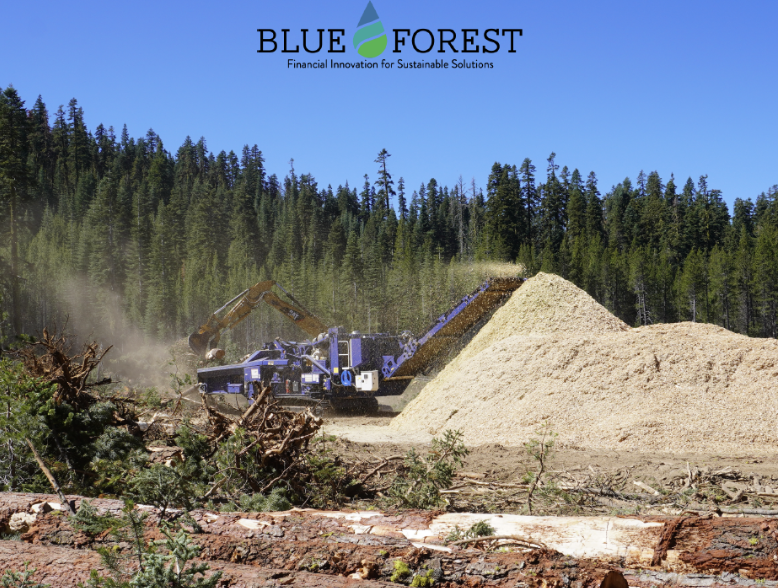June 2023 Science Corner | Financial Analysis of Innovative Wood Products and Carbon Finance to Support Forest Restoration in California


A recent paper led by Blue Forest Senior Scientist Micah Elias explored the financial viability of products made from low-value biomass under different climate policy and market scenarios.
Authors: Micah Elias, John Dees, Bodie Cabiyo, Phil Saksa, Daniel L. Sanchez
Science Corner by: Kirsten Hodgson
Forest management is critical for increasing the resilience of California’s dry, fire-prone forests and decreasing the risk of high-severity wildfires, but implementation of this much-needed work faces multiple challenges. One major bottleneck is that traditional funding sources (including grants, appropriations, and timber sales) are insufficient to support the landscape-scale projects that are needed to move the needle on forest health. As a conservation finance organization, Blue Forest helps to alleviate this constraint by utilizing innovative, upfront financing for restoration through our Forest Resilience Bond.
Typical forest restoration activities generate large amounts of biomass, including small diameter trees and other plant parts such as the tops of trees and branches, that are not valuable for lumber production. This non-merchantable biomass must be removed from the forest to realize full ecosystem and fire risk reduction benefits, but because of its low value, removal is often not economically feasible. As a result, such biomass is either left to decompose or consolidated into large piles at the restoration site and burned (called “pile burning”) – which releases carbon and other gasses and particles into the atmosphere. Identifying economically viable uses for low-value biomass can facilitate its removal from restored landscapes, contribute funding for forest restoration, and have positive climate impacts. However, many questions remain about the viability of various products made with low-value biomass and about the economic and policy conditions that might better support their viability. A recent paper led by Blue Forest Senior Scientist Micah Elias explored the financial viability of products made from low-value biomass under different climate policy and market scenarios.
The authors analyzed 12 fuel (products used for energy generation, such as hydrogen, renewable natural gas, and biopower) and non-fuel wood products (products not used for energy generation, like oriented strand board and biochar) to quantify their carbon benefit–the lower carbon emissions expected from using biomass instead of fossil fuels and long term carbon storage benefits–and explore their economic feasibility. They also incorporated three climate policy and market scenarios to examine the effects of low, baseline, and high carbon incentives on the economic feasibility of these products.
“We found that there are several profitable uses of non-merchantable biomass, but we need to ensure long-term policy support and viable end markets in order to drive large scale investment into this space,” said Elias. Hydrogen with carbon capture and storage (CCS) and pyrolysis fuels were both found to be highly profitable across carbon incentive scenarios, with internal rates of return in the low incentive carbon scenario of >45% and >20%, respectively. Fuel products paired with CCS are the most carbon-beneficial products, due to the benefits of both carbon storage and the substitution of biomass for fossil fuels. Several of the fuel products included in the study are still highly profitable when the biomass that is used to create them costs more than $100/ton, indicating that they are viable options for providing additional revenue to forest restoration projects.
Non-fuel products, like biochar and oriented strand board (a construction material similar to particle board), have overall lower internal rates of return (9-11% and 11% in the low incentive scenario, respectively) that are more sensitive to various parameters, particularly the price of the primary product (hydrogen, gas, biochar, etc). These products will require stable markets to support their continued profitability and feasibility.
Developing and strengthening these markets for low-value biomass products can contribute to a robust wood products industry, but also open up funding for forest restoration and support climate-beneficial outcomes of restoration projects. “Biomass utilization is both a barrier and opportunity to reach forest restoration goals,” Elias explained. “In order to realize the carbon benefits of biomass utilization and provide additional funding to forest management, we need to develop transparent and predictable supply chains for biomass which is currently considered a waste product.” Markets for low-value biomass can help diversify funding streams for restoration, alleviating bottlenecks and increasing the pace and scale of projects.
Addressing the woody biomass bottleneck aligns with Blue Forest’s work to harness financial innovation to further sustainable solutions and advance forest management. In 2023, we launched Blue Forest Asset Management and the California Wildfire Innovation Fund to invest in the forest restoration, wood utilization, and wildfire mitigation sectors. The fund will support projects that add infrastructure and human resource capacity, create value for non-merchantable timber and woody debris, and achieve long-term carbon sequestration and storage. “The California Wildfire Innovation Fund provides an opportunity to invest in sectors that can provide broad benefits to the areas most at risk for high severity wildfire,” said Elias. “This and similar research provide a starting point for evaluating where financial, ecological, and social synergies exist.”